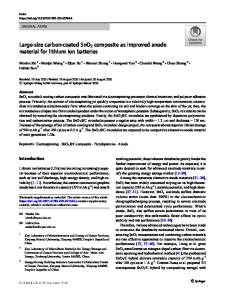Synthesis of Chl@Ti 3 C 2 composites as an anode material for lithium storage
- PDF / 1,198,826 Bytes
- 8 Pages / 595.276 x 785.197 pts Page_size
- 42 Downloads / 367 Views
RESEARCH ARTICLE
Synthesis of Chl@Ti3C2 composites as an anode material for lithium storage Wenxin Xu1, Xin Zhao1, Jiali Tang1, Chao Zhang1, Yu Gao1, Shin-ichi Sasaki2,3, Hitoshi Tamiaki2, Aijun Li (✉)1, Xiao-Feng Wang (✉)1
1 Key Laboratory of Physics and Technology for Advanced Batteries (Ministry of Education), College of Physics, Jilin University, Changchun 130012, China 2 Graduate School of Life Sciences, Ritsumeikan University, Shiga 525-8577, Japan 3 Nagahama Institute of Bio-Science and Technology, Shiga 526-0829, Japan
© Higher Education Press 2020
Abstract Two-dimensional (2D) titanium carbide MXene Ti3C2 has attracted significant research interest in energy storage applications. In this study, we prepared Chl@Ti3C2 composites by simply mixing a chlorophyll derivative (e.g., zinc methyl 3-devinyl-3-hydroxymethylpyropheophorbide a (Chl)) and Ti3C2 in tetrahydrofuran, where the Chl molecules were aggregated among the multi-layered Ti3C2 MXene or on its surface, increasing the interlayer space of Ti3C2. The as-prepared Chl@Ti3C2 was employed as the anode material in the lithium-ion battery (LIB) with lithium metal as the cathode. The resulting LIB exhibited a higher reversible capacity and longer cycle performance than those of LIB based on pure Ti3C2, and its specific discharge capacity continuously increased along with the increasing number of cycles, which can be attributed to the gradual activation of Chl@Ti3C2 accompanied by the electrochemical reactions. The discharge capacity of 1 wt-% Chl@Ti3C2 was recorded to be 325 mA$h$g–1 at the current density of 50 mA$g–1 with a Coulombic efficiency of 56% and a reversible discharge capacity of 173 mA$h$g–1 at the current density of 500 mA$g–1 after 800 cycles. This work provides a novel strategy for improving the energy storage performance of 2D MXene materials by expanding the layer distance with organic dye aggregates. Keywords zinc chlorin aggregate, Ti3C2 MXene, anode material, lithium storage
Received April 7, 2020; accepted July 3, 2020 E-mails: [email protected] (Li A); [email protected] (Wang X-F)
1
Introduction
Li-ion batteries (LIBs) are key energy storage technology, widely used in portable consumer electronics and electrical (hybrid) vehicles [1–7]. Anode materials play an important role in the performance of LIBs by accommodating as much as possible Li-ions during the discharging process [8–10]. To facilitate the intercalation of Li ions, specific anode materials with two-dimensional (2D) morphologies and ultrahigh surface areas are the most promising candidates in LIB. To date, some 2D materials, such as graphene [11], layered oxides [12], and nitrides [13], have been investigated as anode materials in LIBs and exhibited excellent performance. In particular, MXenes, a novel class of 2D transition metal carbides and nitrides, have a high potential as electrode materials for LIBs. MXenes can be prepared by selectively removing the A elements from the bulk Mn+ 1AXn (MAX) phase, where M is an early transition metal, A is III or IV A-group elements,
Data Loading...











